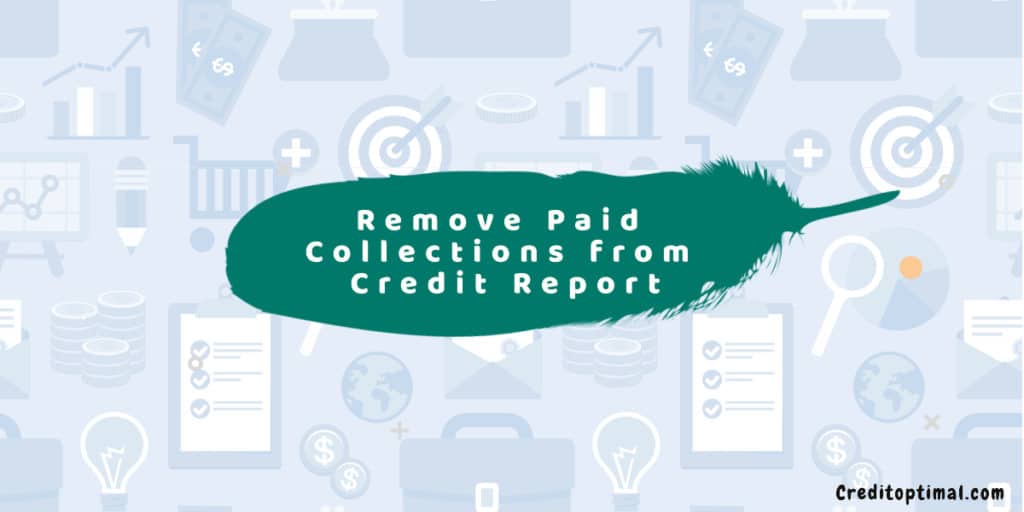Are you scouring the market to own a home, buy a car, or get perfect interest rates for a loan?
If you’re looking to fund a new idea with a loan, you should comprehend how your credit score matters.
Several factors contribute to your credit score: payment history, amounts owed, credit mix, duration of credit history, new credit: and all contribute to your score in different proportions.
Creditors review all these components and put immense weight on your payment history, and this leads to why a terrible payment history may tell a lot about your creditworthiness.
Essentially, an adverse payment history leads to payment collections that occur when you fail to settle payments upon which you agreed with the creditor.
A collection is a clear indication to creditors that you’re a potential credit risk since you’ll likely neglect your financial obligations and ignore the agreements you made with them.
While having zero paid collections is the perfect way to approach credit issues, you can remove any collections if they exist.
How loans end up being collections
When you seriously default a loan or credit card, the loan issuer might transfer your account to a debt collection agency or involve their internal collection department. The creditor usually makes such efforts primarily to collect the debt.
Collection accounts often originate from unsecured accounts like credit cards, personal, and student loans. They can also stem from other accounts like utilities and medical accounts.
If your loan is transferred to a debt collection company, your original creditor will stop pursuing it, and the collection company would instead pursue the money.
How collection accounts stain your credit score
Once a loan turns into a collection, and it’s recorded in your credit report, you’ll likely see a significant plummet in your credit score.
If you previously had a good report and there was no negative item, this score could drop by as much as 100 points.
The severity of how the collection account will affect your credit score will depend on how bad it is.
This means that a collection wouldn’t impact people with good credit as much as it would affect those with bad credit.
You should also remember that the collection’s immensity on your credit score would likely reduce as time goes by.
Paid and unpaid collection
One great misconception that people have is that paying a collection would guarantee its deletion form your credit report.
Remember that, unless you use legitimate ways to remove the collection, it will stick to your report even if it’s a paid collection.
Therefore, the appearance of such a collection would affect the lender’s decision to give you money, and in rare circumstances, you’ll have limited ability to negotiate for favorable interest rates.
When you have a collection, there is some likelihood that some delinquencies associated with the same debt are in your credit report.
Since the late payment entries are not always separate from the collections, you can remove them separately from the report.
How to know you have a collection in your account
The preliminary step when you want to remove a collection from your report is identifying whether there are any that exist.
You must first pull the three reports from the credit information centers – TransUnion, Equifax, and Experian – without hurting your credit score.
The federal law allows you to have credible information in your credit report, and if you fulfill either of the following requirements, you can retrieve your report:
- Request a report and proving that you’re a recipient of public welfare through a formal writing
- You suspect there are errors or incidences of fraud in your report
- Have an “adverse notice,” which means your application for a loan was unsuccessful.
- You are unemployed and are planning to apply for employment within two months (60 days) of sending the request.
Often, there are incidences of reporting inaccuracies, which is the top reason you should compare information retrieved from the three bureaus.
There is a significant disparity between applying to check your credit report and only viewing your credit score. In this case, you won’t have to pay for anything as opposed to applying for credit or paying to check your score.
Primarily, you’ll have to check the report and access the eligibility of that information. The data includes names you used previously, current and past addresses, existential loans, liens, judgments, lines of credit, and collections.
Since all these components could affect your eligibility of several items, including getting a job, you should attach the utmost importance when reviewing them and report to the three agencies if you spot any inaccuracies or possibility of fraud.
Typical collection accounts: what are they?
If you’re wondering what sort of institutions report bad credit or collections, you may be astounded by how different they are. Typically, the following companies perform voluntary reporting:
- Cell phone institutions
- Student loan companies
- Car dealers
- Mortgage services
- Commercial and residential rental institutions
- Government institutions like courts
- Credit card companies
- Utility companies dealing with monthly payments
The company report defaulted amounts that go beyond $100 or the past 30 days. Some smaller amounts, however, may stay in the report.
Different companies have various time frames that they list defaulted amounts, and the more significant it looks in the eyes of your potential lender, the worse impact it will have.
Open date of a collection and the removal: their relationship
Does the opening date of the collection account determine when it will be removed?
Sometimes it takes over a year to sell an account to a collection agency after the charge-off, and collection agencies that unsuccessfully try to collect the owed amounts may sell the accounts to other collection agencies.
If several agencies fail to collect the debt sequentially, you might see several collection agencies appearing on your report – which certainly isn’t good news.
However, you don’t need to whine since any collection agency that appears on your report due to the original debt wouldn’t necessarily take the standard 7-year countdown to expire. Any collection entity would drop seven years from the date of the initial delayed payment that caused the charge-off.
How to Remove Paid Collections from Your Credit Report
Primarily, the original creditor and the collection agency would want compensation for the services they offered.
You may consider calling the collection agency or loan issuer, but that is not always viable.
What you need to do is pull your credit report and review it for errors, note any discrepancies as well as collection accounts that you might want to be removed from your report.
The next step is disputing it if it’s inaccurate or if it’s sold, ask for a goodwill adjustment, wait it out, or pay for delete.
The following strategies would show exactly how to go about the same.
Disputing it with the agencies
You may have a wrongfully included collection, too old to be reported, or the collection itself is inaccurate.
Collections should automatically drop after seven years, but if the debts longer after this period, file a dispute with the credit information center that still displays this information.
If you don’t recognize the paid account or collection, gather sufficient documentation to support your case, then file a dispute using the bureaus’ dispute channels. Preferably use certified mail then wait for 30 days for them to respond.
If the error emanates from the credit collectors, ask the collection agency to validate the debt to clear any doubts. Remember that you’ll be limited to 30 days from the date the collection agency first reached out to you to dispute the report’s validity.
Asking for a goodwill adjustment
This approach works through asking the loan issuer or collection agency to remove the collection if you already cleared the debt.
Write a letter highlighting the circumstances that contributed to the delinquency and explain why you would want it removed – such as if you’re going to apply for a new credit card loan.
While there’s no guarantee that this approach will work, asking won’t cause any harm. You should, however, remember to include any supporting documentation that shows a history of consistent positive payments to help your case.
The credit history would show the defaulted payments leading to the collection, and removing the collection would ultimately remove the scar in your report.
Pay-for-delete
This approach is usually an unlikely option for most people.
It works when the debt collection agency removes the collection from your account in exchange for a partial or complete settlement of the loan.
While the collection will undoubtedly get deleted from your report, the negative information about the late payments will persist.
However, successfully removing a collection using this process is preferably a wrong way and would most likely be impossible.
This is because doing so might reduce the consequence immensity of defaulted payments and encourage people to avoid clearing old debts.
Primarily, the credit bureaus sign agreements with collection agencies and ask them not to delete settled accounts since it’s a great way to put immense pressure on people and encourage them to pay off old debts.
For instance, someone might not bother about an old student loan for which the collection agency is calling them since they would pay for its deletion after all. In such circumstances, collection agencies resolve to keep such collections in accounts unless the information is inaccurate.
Besides, if a collection agency deletes collections, it would lose the right to report accurate information to the bureaus, and no agency would want to be put off business.
For this reason, the agencies attach lots of weight to the agreements, and paying for removal may sometimes be unsuccessful.
Improving your credit when you have collections
If you can’t prove the inaccuracies, it means you have genuine collections, and there’s nothing much you can do to remove them from your report.
You can take the steps below to build your credit even if you have existential collections:
- Clear your bills on time since lenders use your history to predict future behavior, and missed payments could be a red flag.
- Maintain your credit utilization ratio under 30%.
- Avoid closing unutilized credit cards unless they’re costly to maintain.
- Check your credit reports frequently for inaccuracies and dispute them appropriately.
- Apply for new credit accounts only when necessary.
Conclusion
The end game is essentially keeping a good credit history and checking your report for any possible blemishes.
You can use any appropriate method to remove collections from your account, though some might be unsuccessful.
If you feel that your need may necessitate the usage of other approaches beyond the ones listed above, you might seek help from a credit repair company that can eliminate the items that tank your credit score.
Once you have the collections removed, you can pursue a fresh start and engage in positive financial activities that would help you achieve a perfect score, free of collections.


